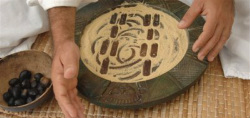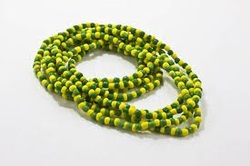Orula, The Master Diviner

Orula
Orula (Orúnmila) is a major Orichá, and he's unique in several ways. First, men and women who are initiated into Regla de Ocha or Santería don't ever have Orula seated on their head as a guardian angel. Orula only goes to the head of Babalawos, heterosexual men who have been initiated into Regla de Ifá. Ocha and Ifá are parallel traditions in Cuba, and they often work together in the same religious community, each carrying out specific tasks and playing unique roles. Depending on the tradition of a man's lineage, he may not have to be initiated first into Ocha in order to to pass into Ifá. Some men are called directly into Ifá through divination. Women can receive the cofá (or ikofá) de Orula, and any man can receive mano (abo faca) de Orula; this puts them under Orula's protection but doesn't fully initiate them into Ifá or make them a Babalawo. Orula is the master diviner. According to the patakís (sacred tales), Orula is the only Orichá who knows the future of everyone on earth and has the power to influence our destiny, because when Olodumare was creating the universe, Orula was the only one present to witness it all. Specifically, he knows when each of us will die, and he makes sure we die at the right time, in line with the destiny we chose for ourselves in heaven. He knows how we can find happiness, health, peace of mind, and success, because he was present when we came into the world, and he knows what future awaits us. He can help us avoid mistakes by keeping us on the right path. Orula communicates with humans through divination with a Babalawo. Babalawos don't use dilogún (cowrie shells) like Santeros/as do. They use either an epuele (divining chain) or ikines (kola nuts), and a wooden divining board covered in cascarilla (eggshell powder). They may also use a piece of horn from a stag's antler to mark certain odu (sacred signs) on the tray.
How Orula Became a Diviner

The divining tray
Some patakís talk about Orula's life in heaven, and others talk about his life on earth. In his earthly form, he's usually considered to be the brother of Eleguá, Changó and Ogún, and the son of Obatalá and Yemú (Yembó). When Ogún disgraced himself trying to have sexual relations with his own mother, Obatalá was so furious, he ordered that all of his male children be killed. Those who were old enough to survive on their own, like Ogún and Eleguá, left home, but Eleguá, like always, kept an eye on things at Obatalá's house. When Changó was born, Eleguá knew that Obatalá would kill him if he found out the baby was male, so he scooped him up and ran to the house of his older sister, Dadá, and gave her the baby to raise. A while later, Orula was born, and Eleguá again grabbed the baby and ran. He didn't know what to do with him, so he buried him at the foot of a Ceiba tree and took food to him every day so he wouldn't starve. Time passed, and one day Obatalá fell gravely ill. Eleguá knew that Changó had become a great healer, so he went to get him and take him to Obatalá, so Obatalá could be cured. Changó worked a miracle and Obatalá was restored to health. Eleguá thought this would be a good time to ask Obatalá for a favor, so he asked his father to pardon Orula. Obatalá agreed, and to celebrate this, Changó cut down the Ceiba tree and carved a beautiful divination tray out of the wood, and he gave the secret of divination to Orula. That's when Orula became the owner of the até (wooden divination tray) and the only Orichá who can work with the oracle of Ifá. And that's why Orula's best friends are his brothers, Changó and Eleguá. Orula figures prominently in many patakís. In some he was married to Ochún, and in others he was married to Yemayá. One story says that Yemayá learned the skills of divination (with cowrie shells) by spying on Orula from behind the door.
Orula's Traits

Orula's eleke
Orula possesses and personifies wisdom, but he's also a powerful healer. He works with herbs and roots to cure people. His colors are yellow and green, and his eleke (beaded necklace) is made of yellow and green beads, alternating. Men and women who've received the mano de Orula or cofá de Orula wear a simple yellow and green beaded bracelet on the left wrist to protect them from premature death. Orula knows the moment when everyone is destined to die, and those who wear the idé (bracelet) of Orula on the left wrist won't be carried off by mistake by Ikú (death). Orula protects against mental illness and insanity. In the Catholic religion, he's syncretized with St. Francis of Asis, whose feast day is October 4. On October 4, it's important for all the godchildren of a Babalawo to visit him and offer him some kind of derecho (money or gift) to honor Orula. The traditional gift is two coconuts and two candles. In the home, Osún is often kept next to Orula as a guardian. Those who have received cofá or mano de Orula should attend to Orula in a formal way once a month, usually when the moon is new. He receives red palm oil and honey, and we burn two candles in his honor while we whisper prayers and special requests to him. In some lineages, Orula's day of the week is Sunday, but in other houses, every day of the week is Orula's.
